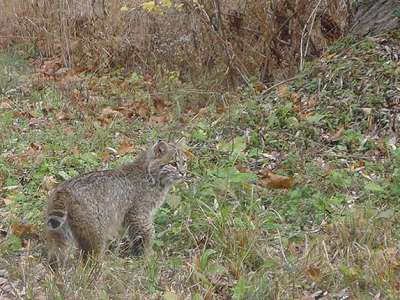
It was probably 105 degrees in the shade – a typical July afternoon in southwestern Oklahoma. I crept closer to the rocky outcrop where I suspected the bobcat was trying to hide from the heat. Several months earlier, this particular bobcat had been captured and equipped with a radio collar. And although I had determined his location many times since his initial capture, I hadn’t had a chance to get a good look at him since. Within 10 yards, I got my camera ready. But in an instant, a speckled, brown blur disappeared over the hill.
Bobcats are dramatic, mysterious, and almost never seen by people. For those of us lucky enough to have spotted a bobcat in the wild, it can be a powerful reminder that not all of nature has been tamed. In recent years, populations of bobcats have increased throughout much of United States, which raises the question of how these shy, secretive animals will handle increased contact with people.
Other predators have made the best of a changing world. Raccoons have a long history of co-existing with civilization. More recently, coyotes have become established in such places as metropolitan Chicago and New York City. Fishers, once thought to be restricted to the big woods of the North Country, are now resident in the suburbs and scattered woodlots of such cities as Albany, New York.
Bobcats historically have had trouble in human-dominated landscapes; there’s been documentation of their populations dropping in areas once roads and houses become abundant. But recently, they’ve been returning to regions they left years ago and demonstrating a surprising degree of adaptability. What explains the recent increase in bobcat numbers? To appreciate their recent success, it is important to understand the factors that reduced bobcat populations decades ago.
Rise and Fall
As a wildlife ecologist, I’ve had the chance to study bobcats in Oklahoma, Maine, and most recently in New Hampshire. In each case, I’ve observed them to be dependent on habitats that support rabbits and hares, their major prey. For example, if we look at the forest history of the Northeast, we see that when forest conditions are favorable to rabbits, bobcats flourish.
Anyone who has hiked in the woods of New England has encountered stone walls that are a testament to agriculture that once dominated the region. From the initial settlement by European colonists until the mid-1800s, pastures and croplands replaced unbroken forests. But as transportation networks connected more productive farmlands in the Midwest to Northeastern markets, many farms in New England and the surrounding states were abandoned. This created large expanses of brushy thickets that provided ideal habitat for cottontails and hares, as well as ruffed grouse, woodcock, and white-tailed deer. Using nearly 200 years of records of bounty payments and trapper harvests from New Hampshire, we can verify the response of bobcat populations to this land-use change.
The rapid rise of species dependent on young forests was followed by a rapid decline when thousands of acres of these forests matured, most noticeably in the 1960s. Closed-canopy forests are much less suitable for thicket-loving species because older forests lack dense cover for protection and forage at ground level. The pattern experienced throughout the Northeast in response to farmland abandonment is quite similar to what happens after a forest is cleared by a fire or cut, but on a much larger scale.
The subsequent fall of prey populations would suggest that bobcat numbers would also decline, which they did. But one would expect the numbers to stabilize at lower densities, which they did not – at least in New Hampshire. Throughout the 1970s and 1980s, bobcat populations continued to decline. In New Hampshire, annual harvests by trappers and hunters dropped from a record high of 421 bobcats in 1959 to only 14 in 1983. By 1989, bobcat trapping and hunting seasons were closed when the statewide population was probably less than 150.
Several factors likely contributed to this continued collapse of bobcat numbers. The loss of thicket habitats and rabbits was likely the most significant factor – biologists saw this in stomach-content surveys of harvested bobcats. In 1950, rabbits made up almost 50 percent of New Hampshire bobcats’ diet; by 1980, the number was less than 5 percent. But coyotes may have also played a role. Historically, coyotes didn’t live in the Northeast – the first started showing up in the 1950s, and their numbers substantially increased during the 1970s and 1980s. Having to compete with coyotes at the same time that prey was declining no doubt further jeopardized bobcats.
Human exploitation also may have played a role. Historically, bobcat pelts were never in demand and rarely sold for more than $10. But that changed in the 1970s, when international regulations removed the usual sources of spotted-cat fur from the market in an effort to protect cheetahs, leopards, ocelots, and jaguars. Demand for spotted-cat fur remained high, especially in Europe and Asia, and furriers switched to bobcats. Pelt prices quickly reflected that new demand. Bobcat pelts from the northwestern United States were particularly sought after because of their distinctive spotting pattern – they have whiter and more clearly spotted bellies than our eastern cats. Fur prices for one pelt fetched as much as $400. Pelts harvested in the Northeast usually sold for $80 to $100. This increase in commercial value likely encouraged trappers and hunters to focus on bobcats.
The final blow was a series of severe winters during the late 1970s and early 1980s, which caused additional mortality. Bobcat kittens are especially vulnerable to starvation when snowfall accumulates for extended periods. As a result, the perfect storm of factors caused substantial declines in bobcat populations throughout the Northeast until the late 1990s.
Increased Interaction
Recently, things have started to change. As bobcat sightings grew in the state, my colleagues and I at the University of New Hampshire established a website and asked New Hampshire residents to report their sightings of bobcats and send us any pictures. In a matter of weeks, reports came in by the dozens. In several years, we tallied over 1,000 sightings that spanned over 70 percent of the state’s townships, including those in the developed southeastern region, where bobcats had been absent for decades.
The forest in New Hampshire has continued to mature, which limits rabbits and hares. So how is the bobcat comeback possible without a growth in their primary food source? Some speculate that bobcats may be benefitting from a new food source – wild turkeys. The restoration of wild turkeys in the Northeast has been an unprecedented success. Much of the establishment and expansion of turkey populations in the region occurred during the 1980s and 1990s, when bobcat populations were low. As it turns out, since 2007, a number of reported sightings and photographs have been of bobcats stalking turkeys.
Other sightings included bobcats positioning themselves near bird feeders and regularly attacking squirrels or turkeys that came to the feeders. So it seems that bobcats have figured out that some of the best hunting may be in backyards. This hunting strategy may be especially important for juvenile bobcats as they leave the care of their mothers during their first winter. Deep snow can effectively conceal the mice and voles that kittens depend on. So finding a bird feeder that is regularly raided by squirrels may get a young bobcat through the worst of winter.
Modifications in an animal’s behavior, like stalking prey at bird feeders, may simply be individuals responding to a changing world. We aren’t too surprised by the ability of a raccoon to associate a trashcan with potential food. After all, raccoons have been living among people for generations. But for a bobcat to venture into a backyard and wait to ambush a squirrel or turkey at a bird feeder is an unexpected reaction. Such dramatic and sudden changes in behavior may require a more complete explanation.
Recently, animal behaviorists have coined the phrase “synurbanization,” which means adapting to the urban environment. Research in Europe has demonstrated that city blackbirds are genetically different from their country cousins. The genetic difference among city birds results in their tendency to explore new and sometimes dangerous areas. To explore new and potentially risky environments comes with potential hazards – an eager house cat ready to pounce, for example. But it often comes with the discovery of new food sources. As a result, the risk-taking birds have become very successful in urban environments. Could the same process explain the very rapid increase in suburban bobcats? Maybe.
As bobcats have more frequent encounters with humans, there are likely risks to both bobcats and humans. Given the amount of space occupied by a bobcat – approximately 10 square miles for females and at least 25-30 square miles for males – bobcats in more developed landscapes often cross roads, putting themselves at risk of being hit by a car or truck. Multi-lane roads in particular can become effective barriers that prevent bobcat movement. We’ve detected a pattern of genetic separation among bobcats living on opposite sides of Interstate 93 in New Hampshire.
In addition to the risk of vehicle collisions, bobcats living in developed areas frequently encounter humans and their dogs, adding further danger. Rory Carroll, a doctoral student, and professor Marian Litvaitis at the University of New Hampshire are examining how bobcats respond to the nonlethal stressors of living in more developed landscapes. As an animal experiences stress, it releases hormones into the bloodstream that trigger a “fight or flight” response. Chronic stress can cause a decreased immune function that increases susceptibility to disease and parasites. High stress levels also inhibit growth and reduce reproduction. Because stress hormones in the bloodstream are incorporated into growing tissue, including hair, these researchers have a signature of the stress levels a bobcat has experienced since its last molt. Preliminary results show that bobcats living in more developed landscapes do indeed show signs of greater stress, but it isn’t clear yet whether the levels of stress detected are detrimental to the health of the bobcats.
Living with humans presents obvious challenges to bobcats, but there also may be consequences of revitalized bobcat populations for humans. Nearly all wild animals have some capacity to spread diseases or parasites to humans and their pets. Bobcat fever, for instance, is caused by a protozoal organism transmitted to domestic cats by tick bites, and the natural reservoir host is the bobcat. This disease can be fatal to house cats, and the number of infections may increase as bobcat populations increase. The disease may be limited by the range of the lone star tick; it has reached as far east as Pennsylvania. Bobcats can transmit rabies, but given their scarcity, humans are far more likely to encounter a raccoon, skunk, or fox with the disease than they are to encounter a rabid bobcat.
On the other hand, research in the western United States has revealed that humans and their pets can transmit diseases to bobcats. Toxoplasmosis is caused by a parasite and can be carried by healthy people with little or no effect, but it can cause complications for infants and adults with compromised immune systems. Toxoplasmosis can be spread by eating poorly cooked food that contains cysts, exposure to infected cat feces, and to a fetus during pregnancy if the mother becomes infected. The parasite is only known to reproduce sexually in wild and domestic cats. Bobcats living near urban areas in California have been found to have higher rates of infection than rural bobcats possibly as a consequence of encounters with domestic cats.
With the increase in sightings of bobcats, I often receive questions regarding potential bobcat attacks. Yes, bobcats are very capable predators. So chickens, domestic ducks, and turkeys warrant husbandry techniques that protect them from all predators – not just bobcats. Cats and small dogs left unattended may also be vulnerable to a hungry bobcat. A recent news story about an attack on a small dog in suburban Massachusetts by a family of bobcats (a mother and two kittens) alarmed many viewers, but such attacks are quite rare. It is important to acknowledge that human populations have expanded into the habitat of bobcats and other species. With time, bobcats have adapted to a changing environment. Now, it is our responsibility to ensure this magnificent animal will continue to thrive.


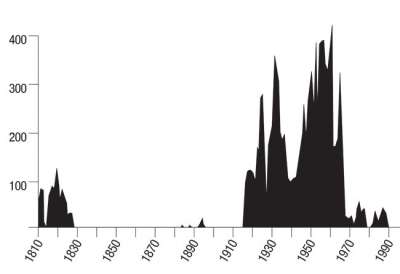
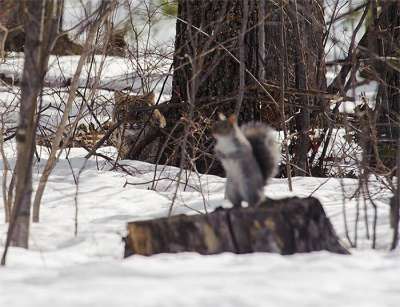
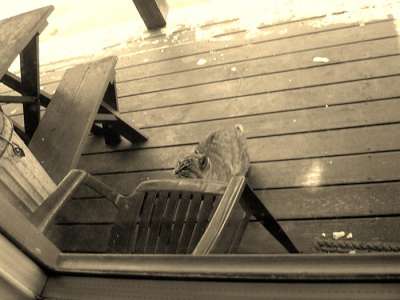
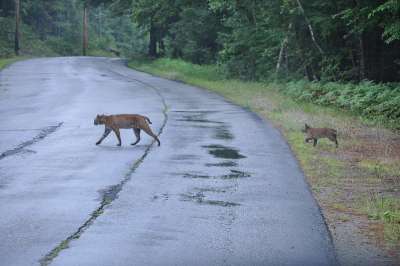
Discussion *